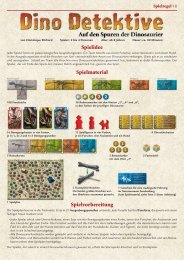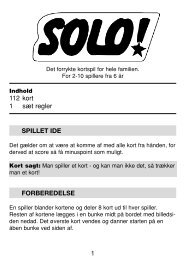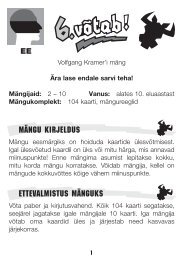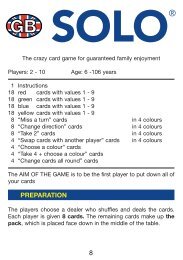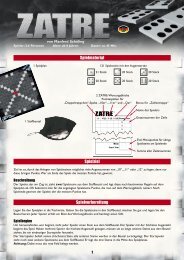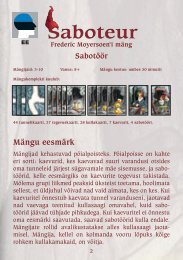Reft & Light - AMIGO Spiel + Freizeit Gmbh
Reft & Light - AMIGO Spiel + Freizeit Gmbh
Reft & Light - AMIGO Spiel + Freizeit Gmbh
Create successful ePaper yourself
Turn your PDF publications into a flip-book with our unique Google optimized e-Paper software.
Reinhard Staupe<br />
Contents:<br />
43 challenge cards:<br />
7 policeman cards:<br />
<strong>Reft</strong> & <strong>Light</strong><br />
Your right hand has its thumb on the left – right?<br />
Each with 3 required movements<br />
Front Back<br />
Please note: When these instructions say „policeman“, this includes policewomen as well.<br />
The idea of the game:<br />
Arrange seven cards in a circle on the table facing up. Each card shows a policeman. You<br />
can either see the front or the back of the policeman. During the game, players will need<br />
to perform three different actions – sometimes to the left and sometimes to the right.<br />
The problem: You always have to know what’s your left and what’s your right, because<br />
“to the left” always means: to the left of the policeman! And “to the right” means to the<br />
right of the policeman, of course!<br />
right left<br />
left right<br />
Players: 2 - 8<br />
Ages: 6 and up<br />
Duration:<br />
approx. 10 minutes<br />
As quickly as possible, the players try to figure out which card they land on when the<br />
three movements have been performed. The first player to name the correct card wins the<br />
challenge cards. The first player who manages to collect six challenge cards wins the<br />
game.<br />
Preparation:<br />
Put the seven cards showing policemen on the table facing up and arrange them in a<br />
circle at random. Their feet point to the centre of the circle. Shuffle the 43 challenge<br />
cards and put them in a pile in the centre of the circle.
Playing the game:<br />
The oldest player turns over the top card of the pile and puts it back on the pile facing up.<br />
The card shows an object and three movements to be performed one after the other.<br />
The objects determines the starting point from which the three movements have to be performed.<br />
The game starts immediately after the card has been turned over. Everybody plays<br />
at the same time; there is no taking of turns.<br />
Each player now tries to figure out (without speaking or using of hands) which card the<br />
three movements will take him or her to. As soon as someone has figured this out, he or<br />
she calls out the name of the object showing on the correct card.<br />
Example: The challenge card shows the house. The<br />
‘journey’ thus begins on the card<br />
showing the policeman with the house.<br />
Starting from this card, move three<br />
cards to the left (from the policeman’s<br />
perspective!), and you land on the card<br />
with the streetlight. Now move one card<br />
to the right – you’ll land on the card<br />
Start<br />
with the tree. Move four cards to the left<br />
to take you to the card showing the bike.<br />
A player calls out the correct answer:<br />
“Bike!”<br />
k The first player to call out the correct answer takes the challenge card from the pile<br />
and places it in front of him or her face-down.<br />
k If a player calls out the wrong object, he or she cannot play again in this round. He<br />
or she must also return one of his or her cards and put it aside, if he or she already<br />
owns any cards. The other players continue until someone calls out the right answer.<br />
Continue playing several rounds in this manner. Turn over the top card of the challenge<br />
pile, all players look for the correct card, one of them calls out the correct object, and so<br />
on.<br />
If two or more players call out the correct object at the same time, they have a play-off.<br />
The current challenge card is removed and put on the bottom of the pile. Then, a new<br />
challenge card is turned over and the players in question play for it. The other players are<br />
not allowed to call anything out during the play-off.<br />
The end of the game:<br />
The first player who has collected six challenge cards wins the game. Of course, it’s possible<br />
to agree on more or fewer cards as a condition for winning, if you like.<br />
For beginners:<br />
Many children (and a number of grown-ups) find it hard to differentiate between left and<br />
right. We suggest you help your children get into the game slowly by having them perform<br />
just one movement at first, taking your cue from the first challenge on the challenge card.<br />
When your children have mastered this, you can move on to the next step and follow the<br />
second and later the third instruction on the card.<br />
What’s the<br />
Time?<br />
Answer:<br />
“Bike!”<br />
The Yellow Series – great games not only for the youngest!<br />
Hoppla-Hop Eagle Eye<br />
Guessing<br />
Numbers<br />
A to Z<br />
Little Rascals<br />
Drop the Sack<br />
For more information, visit www.dieGelbeReihe.de<br />
If you require any more information, feel free to contact us:<br />
<strong>AMIGO</strong> <strong>Spiel</strong> + <strong>Freizeit</strong> GmbH, Waldstraße 23-D5, D-63128 Dietzenbach<br />
www.amigo-spiele.de, E-Mail: hotline@amigo-spiele.de<br />
All My Colours Hamstering<br />
Hotchpotch<br />
© <strong>AMIGO</strong> <strong>Spiel</strong> + <strong>Freizeit</strong> GmbH, D-63128 Dietzenbach, MMIII, MMVIII Version 1.0




